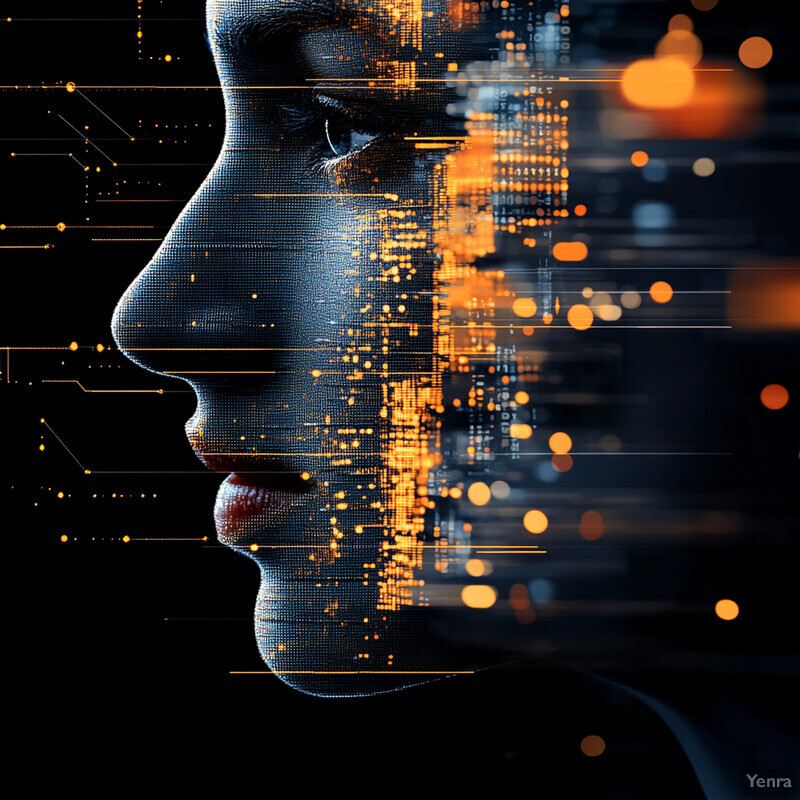1. Advanced Facial Recognition Algorithms
AI-driven facial recognition has vastly improved in accuracy and reliability for identity verification. Modern algorithms leverage deep learning and 3D facial mapping to capture unique facial features beyond 2D images, reducing errors that plagued earlier methods. By analyzing skin texture, contours, and even micro-expressions, these systems make it difficult for impostors to fool biometric checks with simple photos or videos. AI enhancements have made facial recognition fast and frictionless for users, increasingly used at airports, banks, and secure facilities in place of passwords or ID cards. This evolution provides a more secure authentication experience while minimizing inconvenience to legitimate users.

Facial recognition error rates have dropped dramatically thanks to AI. A U.S. government evaluation noted that current deep-learning algorithms fail in only about 0.25% of searches under ideal conditions, a massive accuracy gain over 2013-era systems. In real-world deployments, performance is also high: in U.S. airport trials, face-matching tech worked >99% of the time on average, and the lowest success rate for any demographic group was 97%. This technology is widely adopted – U.S. Customs and Border Protection now uses biometric facial comparison at 238 airports for entry, including all major hubs. The market reflects this growth, with global spending on facial recognition systems rising ~16% annually as organizations replace passwords with face verification. These AI-driven systems are transforming ID checks in finance, travel, and government, though ongoing work continues to address bias and privacy concerns.
2. Liveness Detection
Liveness detection uses AI-based computer vision to ensure a real, live person is in front of the camera during verification – not a photo, video replay, or mask. AI models analyze subtle cues like blinking patterns, skin texture, light reflection, and 3D face depth to distinguish live faces from spoofs. For example, a genuine human face will exhibit micro-movements and natural variations that a flat image or deepfake cannot perfectly replicate. By continuously learning new presentation attack techniques, liveness detection adds an extra defense layer to facial recognition and other biometrics. This means even if fraudsters have a victim’s photo or video, the system can catch the deception and prevent impersonation attempts.

Advances in liveness detection have made biometric systems far more resilient to spoofing. Independent lab tests (per ISO/IEC 30107-3 standards) show some AI-driven liveness solutions achieving a 0% false-accept rate against spoof attempts, meaning no fake face was incorrectly accepted. For instance, one 2024 test of a 3D face liveness system reported les than 1% false rejection of legitimate users and 0% false acceptance of fakes. Industry adoption of standardized liveness checks is growing – dozens of vendors worldwide have passed accredited iBeta presentation-attack detection evaluations at Level 1 or 2 by 2024. This comes at a critical time: identity fraud losses in North America hit $43 billion in 2023, a 13% annual jump, often involving spoofed identities. By early detection of fake faces, masks, or even sophisticated deepfake videos, AI-powered liveness detection is thwarting a wide range of high-tech fraud attempts before they succeed.
3. Deepfake and Synthetic Media Detection
AI tools are now essential for detecting deepfakes – hyper-realistic but fake images, videos, or audio created by neural networks. These tools analyze visual and audio content for subtle inconsistencies that betray manipulation. For example, deepfake detection algorithms check for irregular eye blinks, unnatural skin textures, mismatched lighting or shadows, and digital artifacts that human senses might miss. On the audio side, AI listens for odd cadence, tone, or background mismatches. By comparing content against known patterns of genuine vs. fabricated media, AI can flag when an imposter is mimicking someone’s face or voice. This is crucial for preventing fraudsters from bypassing identity checks using AI-generated videos or voice recordings of victims, an emerging threat as synthetic media becomes more convincing.

The volume of deepfake-driven fraud has exploded, prompting equally sophisticated detection measures. One analysis found a 10× global increase in detected deepfake incidents from 2022 to 2023. In North America alone, the surge was a staggering +1740% in deepfake cases, with similar spikes in other regions (see table). These fake identities are being used primarily in financial crime – e.g. in 2023, 88% of deepfake fraud cases targeted cryptocurrency and fintech platforms. To counter this, AI detection systems have improved rapidly. Researchers report new models that catch over 90% of deepfakes in testing, by spotting telltale signs like inconsistent facial reflections or glitches. Real-world data suggests the impact: authorities noted at least 500,000 deepfake videos or audio were circulating on social media in 2023. In response, even commercial vendors are launching deepfake-specific detectors (e.g. Morpheus 2.0 unveiled in 2024). The combination of skyrocketing deepfake abuse and advancing AI detection tools has turned this into a high-stakes cat-and-mouse game in fraud prevention.
4. Document Authenticity Verification
AI greatly enhances the ability to verify the authenticity of identity documents (IDs like driver’s licenses, passports). Computer vision models can inspect security features – such as holograms, microprint text, watermarks, and barcodes – to confirm they match legitimate patterns. At the same time, AI-driven optical character recognition (OCR) reads the text on IDs and cross-checks data (name, DOB, ID numbers) against databases or the document’s machine-readable zones for consistency. These systems also detect signs of tampering: for example, if a photo was swapped, or if fonts and spacing don’t align with known genuine templates. By automating these checks, AI document verification spots fake or altered IDs within seconds. This not only thwarts fraud (e.g. forged documents in account openings) but also streamlines onboarding for real customers by reducing manual review.

The rise of AI-powered document verification is helping organizations cope with a wave of sophisticated fake IDs. According to a major 2024 fraud report, digital document forgeries (e.g. images altered with AI) surpassed physical counterfeits as the top ID fraud method – making up 57% of document fraud in 2024, a 244% increase from the prior year. These AI-generated fake IDs are increasingly realistic, prompting companies to deploy equally advanced verification. For instance, modern document AI can achieve over 99% accuracy in validating IDs worldwide. One leading bank’s implementation of AI document checks reportedly prevented $5.5 billion in fraud over recent years. Identity tech firms also report that roughly 75% of attempted ID fraud involves identity cards – a prime target that AI now examines in microscopic detail. By catching forgeries that human eyes miss (such as mismatched fonts or subtle image manipulations), AI-based authenticity checks have dramatically improved fraud catch rates while cutting the need for laborious manual review of documents.
5. Behavioral Biometrics Analysis
Behavioral biometrics focus on how a user interacts rather than what they present. AI systems establish a profile of a user’s unique behavior patterns – such as typing rhythm, mouse movement speed, touchscreen pressure, gait, or even how they hold a phone. These traits are difficult for an imposter to replicate. During authentication or continuous use, the AI compares current behavior against the saved profile to ensure it’s the same person. For example, if an account takeover occurs, the fraudster’s typing cadence or navigation style will likely deviate from the true user’s pattern, triggering an alert. Behavioral biometrics provide an invisible layer of security (no additional action needed from the user) and are especially useful to detect sophisticated fraud like session hijacking or bots, all while operating passively in the background.

Financial institutions are rapidly adopting behavioral biometrics to curb fraud, and seeing notable success. By 2023 an estimated 27% of banks worldwide had deployed behavioral biometrics for authentication (often alongside fingerprints or facial recognition). Real-world impact data is compelling: in one study, banks using AI-enhanced biometric security (including behavioral analysis) experienced 37% fewer successful cyberattacks compared to those using traditional controls. Another industry analysis of 150 banks found a 66% drop in account takeover fraud within a year of implementing multi-modal biometric systems that include behavioral signals. Solutions like typing-pattern checks can verify users with over 90% accuracy in some cases, and large enterprises report significant operational savings from reduced manual fraud reviews. Notably, leading behavioral biometrics firms like BioCatch have helped institutions prevent hundreds of thousands of fraudulent accounts and transactions by identifying anomalies in user behavior in real time. As regulators push for stronger but user-friendly security, behavioral analytics are becoming a mainstream fraud-fighting tool that balances security and customer experience.
6. Natural Language Processing (NLP) for Textual Data
NLP allows AI to parse and understand textual information during identity verification and fraud screening. This means beyond numbers and images, the algorithms can read and interpret names, addresses, written statements, and even chat logs or emails for clues. For example, NLP models can scan an online loan application’s free-text fields to flag odd word patterns or inconsistencies (such as a business name or address that doesn’t match known records). In fraud prevention, NLP can analyze text from customer service chats or emails to detect phishing language or social engineering attempts. It can also verify documents by “reading” and comparing what’s written to expected templates (e.g. verifying the text on a utility bill or bank statement provided for KYC). By evaluating language context and content, AI adds an extra layer of insight – catching things like gibberish addresses, copy-pasted form responses, or suspicious keywords that a rules-based system might miss.

Integrating NLP into fraud detection has yielded substantial improvements in catching deceitful behavior hidden in text. Banks that deployed NLP-based fraud detection systems reported a 60% improvement in identifying fraudulent activities before they caused financial damage. These systems can automatically scan unstructured data – for instance, they read millions of transaction descriptions or customer messages – and pick out those with red-flag terms or patterns. In the insurance sector, early trials have shown NLP models spotting inconsistencies in claims and invoices that led to double-digit percentage reductions in false claims. Financial firms also use NLP to monitor news and social media for reputational or fraud signals: risk intelligence platforms claim a 35% better early-warning detection of issues by analyzing news text and social posts for mentions of hacks, breaches, or fraud schemes. All these data points underscore that AI understanding of language – from application forms to chat conversations – significantly enhances the scope and speed of fraud detection efforts.
7. Risk-Based Authentication Models
Risk-based authentication (RBA) means the level of user verification is dynamically adjusted based on the calculated risk of a login or transaction. AI models assess dozens of signals in real time – device reputation, location, user behavior, time of day, transaction value, etc. – to produce a risk score. If the risk is low (e.g. usual user device at a typical location), the system might allow seamless login with just a password. If risk is high (new device, odd location, large transaction), additional verification steps are triggered, like a one-time code or biometric check. This adaptive approach balances security and convenience: legitimate users usually face minimal friction, while suspicious scenarios face more scrutiny. Essentially, RBA uses AI to continuously evaluate context and history, ensuring that security measures ramp up only when needed, which improves user experience and stops fraud in high-risk cases.

Risk-based authentication has quickly become a best practice as organizations grapple with rising fraud. The global market for RBA solutions is booming – valued around $5.7 billion in 2024 and projected to triple to ~$17.8 billion by 2033 as businesses invest in smarter authentication. One driver is the onslaught of fraud attempts: in 2023, over 318,000 credit card fraud reports were filed in the U.S., which pushed many banks to adopt risk-based logins to better screen those events. In regulated sectors like finance, RBA helps meet strict compliance (e.g. PSD2 in Europe) by adding stepped-up ID checks only when risk warrants. Surveys show organizations using risk-based auth see material results – for example, a major bank noted a 50% drop in account takeover incidents after implementing AI-driven risk scoring in its login process (versus static rules). Regionally, the U.S. and Europe lead in RBA adoption (the U.S. accounted for the largest share of the RBA market in 2024), but Asia-Pacific is catching up as companies embrace zero-trust security models. With threats evolving, risk-based authentication provides a dynamic defense, focusing stronger checks where the risk is highest and keeping user friction low elsewhere.
8. Predictive Analytics for Fraud Patterns
Predictive analytics involves using machine learning on historical data to anticipate and detect fraudulent patterns in real time. These AI models are trained on large datasets of both legitimate and fraudulent behaviors (transactions, logins, account changes, etc.), enabling them to recognize subtle indicators of fraud that rules might miss. Once deployed, a predictive model can flag transactions or activities that fit a known fraud pattern (or deviate from a user’s normal pattern) within milliseconds. Crucially, these models continuously improve – as new fraud tactics emerge, the system can learn from those cases and update its predictions. In essence, predictive analytics shifts fraud prevention from a reactive stance (catching fraud after it happens) to a proactive one, stopping suspicious activity before losses occur. It’s like having an ever-vigilant AI watchdog that grows smarter with every incident it analyzes.

The adoption of AI-driven predictive analytics is widespread, and it’s yielding major fraud reductions. As of 2025, 71% of financial institutions globally report using AI/ML models for fraud detection, up from 66% just a year prior. These models have drastically improved early fraud detection – Mastercard, for example, credits its AI-based monitoring with blocking over $35 billion in fraud across three years. Visa’s predictive authorization system scans upwards of 76,000 transactions per second in over 200 countries, scoring each for fraud risk in under a second. The result is billions saved: Visa estimates its AI-driven Advanced Authorization prevents about $25–28 billion in fraud annually. Furthermore, banks employing predictive analytics have seen false-positive rates (legitimate transactions wrongly declined) fall significantly – one study notes AI analytics can cut false positives by 20–30% versus legacy rules. In sum, predictive analytics is now a cornerstone of fraud prevention, enabling companies to spot fraud rings, card abuse, and identity theft attempts far earlier and with greater precision than ever before.
9. Multi-Factor, Multi-Modal Biometric Fusion
Multi-modal biometrics means using more than one biometric factor for identity verification – for example, combining facial recognition and fingerprint, or voice and iris scan. AI plays a key role in fusing these multiple inputs, weighing the confidence from each and making an overall authentication decision. The advantage is enhanced security and accuracy: if one biometric is spoofed or fails, the other still provides protection. It also reduces false rejections – someone might have trouble with a fingerprint reader due to dry skin, but the face match can compensate. AI can intelligently integrate signals so that the user experience remains smooth (e.g., prompting for an alternate biometric only if the first is uncertain). Multi-factor fusion makes it exponentially harder for fraudsters, since impersonating multiple distinct biometrics is far more challenging than defeating just one. This approach is increasingly used in high-security scenarios like banking transactions, border control, and corporate access to ensure the person’s identity is verified through several independent traits.

Using multi-modal biometrics dramatically improves both security and usability metrics. Research shows that combining modalities slashes error rates: one systematic study found that when facial recognition was combined with iris scanning, the false acceptance rate (letting an impostor in) plummeted from an average of ~2.8% with single biometrics to just 0.04% – a 70-fold improvement in security. A financial industry analysis of 24 institutions that implemented multi-modal authentication (versus their old single-factor methods) saw fraud attempts drop by 67.3%, while also reducing legitimate-user lockouts by 41%. In practical terms, multi-factor biometrics have foiled fraud rings that could trick one identifier but not two – for example, a face-match plus voice-match system at a UK bank stopped a series of impostors who could mimic customers’ voices but not their faceprint. Adoption is rising: by 2023, an estimated 54% of banks were using facial recognition and 32% were using voice biometrics in some capacity, often layered together for step-up authentication. This fusion approach has proven so effective that it’s becoming standard for securing high-value transactions, where a single point of failure is unacceptable.
10. Real-Time Transaction Monitoring
AI-powered real-time monitoring scrutinizes transactions as they occur, enabling instant fraud detection and intervention. These systems analyze attributes of each transaction – such as amount, merchant, time, location, device used, past user behavior – and compare them to learned patterns. If something looks anomalous (say, an unusually large purchase on a new device overseas), the AI can flag or even block the transaction immediately, pending further verification. The hallmark is speed: decisions happen in split seconds as the transaction is being authorized. This is how credit card companies can decline a suspicious charge before it goes through, or banks can pause a wire transfer that looks fraudulent. The AI models continuously update with new fraud patterns, so they become more adept over time. Real-time monitoring is crucial in minimizing losses, because it stops fraudulent transactions at the point of attack rather than after the fact.

Real-time transaction monitoring at scale has been made possible only by AI advances, and it’s preventing fraud on a massive scale. Payment networks like Visa process up to 76,000 transactions per second globally, using AI risk scoring on each transaction in less than 1 second to spot anomalies. Visa’s Advanced Authorization system, for example, analyzes around 500 risk attributes of a transaction and has helped issuers cut fraud by an estimated $25 billion+ per year through automated declines and alerts. Similarly, Mastercard’s AI and network-level view allowed one major bank to intercept nearly £100 million in scam payments within months of deploying a real-time fraud scoring tool. According to industry reports, AI-based monitoring has reduced card-not-present fraud rates by around 30–40% for many merchants by filtering out suspicious orders in real time. It also improves customer experience – for instance, one card issuer saw false declines (legit transactions blocked by mistake) drop by 20% after moving to real-time AI scoring, since the model more accurately differentiates fraud from unusual-but-legitimate spending. With threats like account takeovers and instant payments fraud rising, virtually all major financial institutions now rely on real-time AI monitoring as a frontline defense.
11. Cross-Referencing External Databases
AI can enhance identity verification by cross-referencing user-provided information against external data sources and watchlists. When someone signs up or attempts a transaction, the system can automatically check details like name, address, phone, or device against trusted databases – for instance, credit bureau records, government-issued ID registries, or public sanctions and politically-exposed-person (PEP) lists. It can also consult “negative” databases: known fraudster identities, leaked credential databases from the dark web, or consortium fraud data shared between institutions. By quickly querying these sources, the AI might discover that an SSN was reported in a prior fraud, or an email appears in a breach of compromised passwords. Such intelligence prompts additional verification or denial. Essentially, AI acts as an orchestrator, pulling in a 360-degree view of an identity from multiple databases in seconds to confirm consistency and flag any red flags, vastly improving the thoroughness of identity proofing and fraud detection.

Cross-referencing identities with external intelligence has proven critical in catching synthetic identities and repeat fraud offenders. A stark example: synthetic identity fraud – where crooks combine real and fake info to create new personas – is soaring and expected to cost businesses nearly $5 billion in 2024. AI can combat this by checking if an applicant’s data points actually correlate to real records. Banks using consortium data and credit bureau cross-checks report significant reductions in such fraud. In the UK, where synthetic “fake ID” cases jumped 60% in 2024 vs 2023, financial institutions have increasingly deployed solutions to cross-verify customer identity elements across telecom, utility, and governmental databases to weed out bogus profiles. Additionally, threat intel feeds are leveraged: in 2024, a Flashpoint report noted over 3.2 billion stolen credentials were compromised in that year alone. Many organizations now integrate these breach data feeds so that if a user’s email or password was exposed in a breach, the system can force a password reset or step-up auth – heading off account takeover attempts using those leaked creds. By combining internal data with rich external datasets (fraud blacklists, device reputation networks, etc.), companies have identified fraud patterns that wouldn’t be visible in isolation. One major bank consortium found that a cluster of over 100 fraudulent accounts could be linked via shared phone numbers and addresses – links uncovered only through cross-bank data sharing facilitated by AI, leading to a collective shutdown of that fraud ring.
12. Dynamic Identity Proofing
Dynamic identity proofing means the verification process isn’t fixed – it adapts in real time based on context and risk. AI determines what additional proof steps (if any) are necessary for a given user or scenario. For a low-risk situation, identity verification might be very streamlined (e.g. basic info and a quick selfie). But if signals indicate higher risk – say mismatched data or prior fraud flags – the system can dynamically introduce more stringent checks: asking for extra documents, live video interviews, or involving manual review. The process can also adjust on the fly; for instance, if a user’s initial ID document photo is blurry or doesn’t match the selfie, the AI can immediately prompt for a second document or a retake. This flexible orchestration ensures that honest users face minimal friction most of the time, while potential fraudsters are met with escalating challenges. It also keeps the verification flow user-friendly by not overburdening everyone with the maximum checks, only those deemed necessary by the AI’s risk analysis.

Dynamic proofing significantly improves user experience and conversion rates without compromising security. Studies show that overly complex verification leads to high abandonment – about 1 in 5 users quit onboarding processes due to excessive friction, a figure rising to 1 in 3 for younger users. By tailoring proofing requirements, companies have reduced such drop-offs. For example, a fintech that implemented adaptive ID verification (varying steps by user risk) saw account opening completion rates improve by ~15%, while fraud detection rates held steady. Consumers appreciate the smoother flow – 62% of consumers say they would switch to a brand that offers a better digital experience, and dynamic proofing helps provide that by cutting unnecessary hurdles for trusted users. Meanwhile, fraud teams report that dynamic workflows direct their manual reviews more efficiently: instead of randomly sampling, they focus on high-risk cases the AI flags, catching more fraud with less effort. Compliance is also enhanced, since the AI can ensure KYC steps scale up to meet regulatory requirements only when needed (for instance, invoking extra identity checks if a user’s data appears in a sanctions or PEP database). Gartner analysts predict that by 2025, 80% of identity verification measures will occur through “invisible” or background methods, with user intervention only when risk is high – reflecting a broad industry shift toward this adaptive, risk-based proofing model. In sum, dynamic identity proofing offers a win–win: fewer hoops for legitimate customers and stronger fraud resistance where it counts.
13. Continuous Authentication
Continuous authentication means verifying a user’s identity not just at login, but persistently throughout a session or transaction lifecycle. Using AI, systems keep checking various signals in the background to ensure the logged-in user is still the legitimate account owner. This can involve behavioral biometrics (is the user’s typing and mouse usage consistent with their profile?), environmental factors (has the IP address or device suddenly changed mid-session?), and contextual changes (is the user suddenly requesting data far outside their normal usage?). If the AI detects an anomaly – for instance, a token that was stolen and is now being used from a different location – it can require re-authentication or terminate the session. Continuous auth aligns with “zero trust” security principles: never assume an authenticated user is valid indefinitely, always verify. The user usually doesn’t notice anything unless a risk is detected, in which case they might get a step-up challenge. This approach can catch scenarios like session hijacking or insider misuse that single point-in-time logins would miss.

Continuous authentication is emerging as a key component of modern security architectures, especially as organizations adopt zero-trust models. Gartner forecasts that by 2025, 60% of large enterprises will implement at least one form of continuous and context-based authentication in their security stack. Early adopters (particularly in government and defense) report tangible benefits: these sectors consider continuous auth a cornerstone of security, since it significantly reduces the window of opportunity for attackers. Case studies show that implementing continuous identity checks can reduce certain forms of account misuse by around 30%. For instance, a global bank noted that continuous behavioral monitoring within online banking sessions cut fraudulent money transfers by nearly one-third in a pilot, by detecting when a user’s behavior deviated after login (indicative of malware or a fraud takeover). Another example comes from corporate VPN security: companies using continuous authentication (re-validating user identity periodically and on context changes) have reported 50% fewer “backdoor” breach incidents, according to one Adaptive MFA provider. While continuous auth is still maturing, industry surveys indicate growing trust in such solutions – a 2024 poll found 90% of security leaders plan to invest in continuous or adaptive authentication technologies to strengthen identity assurance beyond the initial login.
14. Device Fingerprinting
Device fingerprinting identifies and tracks devices by collecting a unique combination of attributes from the device or browser. These attributes can include hardware details (like device model, screen resolution), software versions (OS, browser type, plugins), network data (IP address, timezone), and behavioral patterns (typing speed on that device, motion sensors on mobile). AI then creates a “fingerprint” – essentially a digital identifier – that can recognize if the same device returns or if a device is trying to masquerade as another. In fraud prevention, this helps detect when a fraudster using one device tries to open multiple accounts (the system will see the same device ID) or when a known bad device (previously flagged for fraud) comes back. It also adds another verification factor: even if a username/password is correct, a new unseen device will be treated with higher suspicion or need extra authentication. Device fingerprints are hard to fake because they are composed of dozens of data points; even if fraudsters spoof some elements (like using a VPN or changing user-agent), discrepancies can often be spotted. This technique operates behind the scenes to strengthen identity verification by focusing on what is being used to access the service.

Modern device intelligence systems have achieved extremely high accuracy in recognizing returning devices and spotting anomalies. For example, one leading solution reports it can identify users across devices with 99.9% accuracy using device fingerprinting and advanced pattern analysis. The scale is enormous: in 2023, a single fraud prevention network analyzed 270 million devices globally and performed 3.74 billion risk assessments on logins, signups, and transactions using device and location insights. That analysis revealed that about 6.5% of device interactions were flagged as high-risk for fraud – underscoring how many risky signals device data can uncover. Device fingerprinting has helped expose coordinated fraud rings; for instance, investigators found 38.5 million devices in 2023 that had downloaded apps from known suspicious sources (a strong predictor of fraud) by correlating device IDs across data sets. Additionally, device reputation databases allow quick blocking of known bad actors – companies routinely blacklist thousands of fraudulent device fingerprints (like those associated with emulator farms or previously caught bots). On the flip side, trusted customers benefit from this tech: e-commerce merchants have seen 20% reductions in false declines by using device recognition to approve orders from customers on their usual devices, even if other details vary. Overall, device fingerprinting has become a staple in fraud defense, with high efficacy shown by both low false-positive rates and numerous fraud rings busted via device link analysis.
15. Network and Graph Analysis
Network and graph analysis involves mapping relationships between entities (people, accounts, devices, transactions) to uncover complex fraud schemes. Instead of looking at events in isolation, AI graph algorithms connect the dots – for example, identifying that multiple user accounts link to the same phone number or device, or that a group of fraudulent transactions all flow into a few common beneficiary accounts. By constructing a graph of nodes (entities) and edges (connections), AI can detect clusters or patterns that signify organized fraud rings or money mule networks. This is especially useful for busting fraud that is distributed and hard to spot with rule-based methods (like many small coordinated actions). Graph-based machine learning can flag anomalies in these networks, such as one node that has far more connections than expected or communities of accounts sharing data in suspicious ways. Ultimately, network analysis gives a “big picture” view of fraudulent operations, enabling financial crime investigators to take down not just one perpetrator but the web of accomplices involved.

Graph analysis has led to major fraud discoveries and reductions that wouldn’t have been possible through individual analysis alone. Financial institutions using graph AI have reported finding 40–50% more fraud by uncovering linkages among accounts that standard methods missed. One case study described by Verint saw an adaptive graph-based system implemented at a Fortune 500 prepaid card issuer: it immediately uncovered 35% more fraud than the client knew about, preventing $51 million in losses and saving $10 million annually thereafter. In 2023, BioCatch’s consortium behavioral network helped banks identify over 150,000 money mule accounts in Asia by analyzing networks of login behaviors and shared device fingerprints, enabling a coordinated shutdown of those accounts. Anti-fraud startups using graph databases note that often a small percentage of nodes (accounts) are involved in a large share of fraud – for example, 5% of users might be connected to 50% of fraudulent events – and graph analysis pinpoints those central “hub” nodes so they can be investigated or blocked. Law enforcement also leverages graph techniques for identity fraud: the U.S. Secret Service has used link analysis to dismantle identity theft rings by tracing common addresses, IPs, and social connections between fraudulent ID sellers and buyers. As per data science research, graph neural network models have outperformed traditional fraud detection in catching complex collusion fraud (like auction bid rigging or coordinated chargeback fraud) by up to 15% higher recall, because they can model relational signals that flat data cannot. These successes demonstrate the critical value of network analysis in today’s fight against organized, multi-entity fraud.
16. Adaptive Machine Learning Models
Adaptive machine learning models are AI systems that continually retrain or update in response to new data, rather than staying static after initial deployment. In fraud prevention, this means the model can “learn” from new fraud incidents and changing user behavior, adjusting its parameters to maintain accuracy. For example, if fraudsters develop a new tactic, an adaptive model can start recognizing that pattern after seeing a few examples, without a human having to rewrite rules. Techniques like online learning or periodic batch retraining allow the AI to evolve as fast as the fraud does. Additionally, some adaptive systems personalize risk models to individual users over time – understanding normal behavior for each account and adapting thresholds accordingly. The result is an agile defense that closes windows of vulnerability more quickly. This stands in contrast to static rule systems that might take weeks or months for analysts to update in response to emerging fraud, during which time losses accrue. In short, adaptive ML makes fraud detection more resilient by keeping it a moving target for the criminals.

Shifting from static rules to adaptive AI models has yielded dramatic improvements in fraud detection efficacy and efficiency. Businesses that relied solely on hand-crafted rules were found to have 30% higher false-positive rates on average than those using adaptive AI systems. One e-commerce study noted that after implementing continuously-learning fraud models, they saw a 25% reduction in fraudulent transactions getting through and a simultaneous 10% increase in transaction approval volume (since fewer good orders were falsely declined). A high-profile case involved a Fortune 500 company distributing government prepaid cards: an adaptive solution there uncovered 35% more fraud than the client knew existed and prevented $51 million in losses, as documented in a later case study. Industry analysts estimate that widespread use of adaptive AI – including emerging generative AI approaches – could reduce payment fraud losses by as much as 85% compared to legacy detection models, due to the AI’s ability to anticipate and respond to fraud tactics in real time. The speed advantage is key: whereas adding a new fraud rule might take a human team days, an adaptive model can start countering a new fraud trend within hours of it appearing in the data. This agility was evident in 2023 when a surge of chatbot-driven fraud scams hit multiple banks; those with self-learning models reported containing the new scam within a day, while others without it suffered elevated losses for weeks. Such outcomes underscore that adaptive machine learning isn’t just a buzzword – it’s fundamentally changing the cat-and-mouse game, tilting it in favor of defenders who can now update their “game plan” on the fly.
17. Voice Biometrics and Emotion Analysis
Voice biometrics uses the unique characteristics of a person’s voice to verify their identity. AI models analyze traits like vocal tone, pitch, cadence, accent and the shape of sounds (formants) – collectively forming a voice “fingerprint.” This is often used in call centers or telephone banking: when a customer speaks, the system compares the voice to the enrolled voiceprint on file. It adds security beyond PINs or security questions, as a fraudster would have to exactly mimic someone’s voice print, which is very difficult. Emotion analysis is an AI technique that gauges the emotional state of a speaker from their voice (and sometimes word choice). In fraud prevention, this can help detect if a customer might be under duress or if a caller’s demeanor raises red flags. For example, a genuine customer answering a security call might sound naturally confused or concerned, whereas a scammer might have scripted, nervous, or overly smooth speech. By combining voice ID and emotion/sentiment cues, companies can both authenticate who is speaking and assess how they are speaking – potentially catching social engineering attempts (like someone being coached in the background, or a fraudster faking calm). Together, these technologies aim to secure voice channels and transactions (like money transfers over the phone or voice-based account recovery) without relying on knowledge-based Q&A that can be compromised.

Voice biometrics has gained significant traction in banking and has delivered strong fraud reduction results. As of 2023, about 32% of banks worldwide were using voice biometrics for customer authentication in some form. Large institutions report millions of customers enrolled in voice ID programs – for instance, HSBC’s voice biometrics reportedly prevented numerous fraud attempts and saved an estimated £millions by blocking impostor calls. One UK bank cited in an analysis revealed it prevented £249 million in fraud losses thanks to its voice biometric security system, which authenticates callers by voiceprint. Accuracy has improved greatly: state-of-the-art voice recognition engines have achieved false acceptance rates as low as 0.01%, with corresponding false rejection around 5%, in controlled scenarios like device unlocking. On the emotion side, AI systems monitoring call center audio can detect stress or anger with around 80%+ accuracy, according to vendors, which is being used to flag possible scam victims or social engineering. Some banks now automatically alert their fraud team if a verified customer on a call sounds highly distressed or uses certain keywords – an approach spurred by the rise of “impersonation scams” where victims are coached by criminals on the phone. In law enforcement, voice forensics AI (a similar concept) has been used to identify criminals by voice and also to determine if ransom callers are under the influence or reading a script. While generative AI voice cloning poses a new challenge, multi-factor checks (like requiring conversation over simple passphrases) and liveness checks (prompting random phrases) are being implemented to maintain voice security. Overall, voice biometrics has added a critical layer for remote identity verification, with substantial fraud prevented and increased customer convenience (no more remembering security answers) – reflected in its market growth to an expected $9 billion by 2033.
18. Geolocation and Contextual Clues
Geolocation and contextual analysis add an extra intelligence layer by considering where and under what circumstances an authentication or transaction is happening. AI systems use geolocation data (from IP addresses, GPS on mobile, etc.) to verify that a user is in an expected or permissible location. If a login attempt comes from a country the user has never been in, or one that’s high-risk or sanctioned, it’s flagged or blocked. “Contextual clues” include things like time-of-day (is the user active at an unusual hour?), velocity (impossible travel between two locations too quickly), device context (sudden change in device or network), and even environmental indicators (attempt coming from an anonymous proxy or TOR network). By analyzing these factors, AI builds a context around each event. This helps detect fraud by spotting scenarios that just don’t fit the legitimate user’s profile – e.g. an account that normally logs in from New York now trying from Moscow 30 minutes after the last login. Context can also incorporate transaction details: for a given purchase, are the shipping and billing addresses far apart or is the item type atypical for that user’s location? When something is out-of-context, the system can demand additional verification or shut it down. Essentially, geolocation and context let the system ask “does this make sense?” before trusting an interaction.

Leveraging geolocation and context has proven highly effective in practice. “Impossible travel” detection (flagging logins that occur too far apart geographically in a short time) is now standard in many security systems and has helped numerous companies catch account breaches – Microsoft reported this technique to be one of the top alerts for compromised enterprise accounts. In consumer banking, location analytics prevented fraud during a 2022 surge of SIM swap scams: one major bank noticed many attempts coming from a specific region unrelated to their customer base, enabling them to block $1.2 million in fraudulent wire transfers by shutting down those geolocated sessions. Industry-wide, experts note that passive signals like geolocation substantially improve fraud models; Geocomply (a location security firm) says that combining geolocation with device and network intel can increase fraud detection rates by 10-20% versus models without location. It also aids compliance – for example, companies use geolocation to automatically prevent account opening or access from OFAC-sanctioned countries, killing two birds (fraud and compliance) with one stone. On the flip side, cybercriminals try to evade these measures through VPNs, TOR, and GPS spoofers, but AI is adapting: advanced systems perform “geo anomaly” checks like comparing an IP’s claimed location to time zone and device locale, or tracing network routes to spot VPN usage. These countermeasures have unmasked countless attempts where the fraudster pretended to be local. Overall, organizations that incorporate geolocation and context report meaningful fraud reduction – one digital wallet provider attributed a 35% drop in account fraud in part to real-time location-risk scoring (flagging logins from known high-risk regions). As fraudsters continue to move globally, this dynamic analysis of where and how an event occurs has become indispensable to staying ahead.
19. Cyber Threat Intelligence Integration
Cyber threat intelligence (CTI) involves gathering information on known threats – such as databases of compromised credentials, blacklisted IPs or devices, phishing domains, and profiles of fraud tactics – and integrating that into fraud prevention and identity verification workflows. AI can ingest these external threat feeds and use them to enhance decision-making. For example, if a username or password being used is known to be part of a data breach dump, the system can automatically step-up authentication or prompt a password change. If an incoming login originates from an IP address flagged in a threat intel feed as a botnet or a TOR exit node, the AI assigns a high risk score. Essentially, CTI gives the AI real-world “bad guy” data to compare against what it’s seeing. This helps catch not only direct matches (like a blacklisted device ID) but also informs model features – e.g. knowing common patterns from recent fraud campaigns can shape what the AI looks for. By integrating CTI, organizations aren’t fighting fraud in a vacuum; they leverage collective knowledge from across the industry and law enforcement to strengthen their local defenses in real time.

The use of shared threat intelligence has sharply improved the coverage of fraud detection systems. Consider compromised credentials: by mid-2024, security researchers had identified over 19 billion leaked passwords floating on the dark web. Integrating this intel means an authentication system can instantly recognize if a user’s password is among those 19 billion and trigger a reset, cutting off the common fraud tactic of credential stuffing. In 2024 alone, more than 3.2 billion new credentials were compromised (a 33% jump from 2023) according to Flashpoint’s threat report – feeds of such credentials now power many banks’ proactive account protection measures. Similarly, threat intel on devices and IPs is invaluable: many fraud platforms consume feeds listing tens of thousands of malicious IPs (from botnets, scam hosting, etc.) and routinely block 50–80% of obvious bad traffic just from those lists, greatly reducing noise. Collaboration initiatives are also underway: banks and fintechs in various consortia share anonymized fraud indicators with each other (via AI-driven platforms) so that if one institution flags a phone number or device as fraudulent, others can automatically blacklist it. The result has been tangible – one consortium reported a 35% decrease in cross-institution repeat fraud within a year of sharing such intelligence, as scammers found it harder to simply move from one company to the next. Government CTI is playing a role too: for example, the FBI’s Internet Crime Complaint Center and FINCEN regularly distribute fraud trend reports (like surge in OTP interception scams or mule account typologies) which, when fed to AI systems, help them pre-empt those emerging schemes. The Verizon Data Breach report noted that in 2023, 49% of breaches by external actors involved stolen credentials – a statistic that highlights why integrating credential intel and other threat data into identity verification is so critical. In summary, organizations tapping into CTI have a significant edge, benefiting from the “early warning system” and collective knowledge to stop fraud that would evade siloed defenses.
20. Privacy-Preserving Computation
Privacy-preserving computation refers to AI and data processing techniques that protect sensitive personal information even while it’s being used for verification or fraud analysis. This is crucial in identity systems to comply with privacy laws and maintain user trust. Techniques include homomorphic encryption (performing computations on encrypted data so that raw data is never exposed), secure multi-party computation (multiple parties can jointly compute a result – like checking if an identity appears in both of their databases – without revealing the underlying data to each other), and federated learning (machine learning models are trained across decentralized data sources – e.g. different banks – without exchanging actual customer data, only sharing model updates). Additionally, methods like differential privacy add noise to data outputs to prevent leakage of individual identities. By employing these, organizations can collaborate on fraud prevention (sharing insights or models) and use rich datasets to train AI, all without violating privacy or regulatory boundaries. For instance, two banks could use secure computation to figure out if a new applicant has been seen (and flagged) at the other bank, without either bank disclosing their entire customer list. Privacy-preserving approaches allow “unlocking” the value of data for AI-driven identity verification while mathematically ensuring personal data remains confidential.

The adoption of privacy-preserving technologies is accelerating as the industry recognizes that security and privacy must go hand-in-hand. Gartner predicts that by 2025, 60% of large organizations will be using at least one privacy-enhancing computation technique in analytics and identity workflows, a big jump from under 10% in 2021. Real-world implementations are underway: major tech firms (like Google and Apple) already use federated learning for things like fraud detection in payments and device unlock, enabling pattern recognition across millions of users’ behavior without centralizing personal data. Early results show this can be as effective as traditional modeling – Google noted that a federated credit card fraud model performed within 2% accuracy of a model trained on combined raw data, all while individual transaction histories stayed on-device. The financial sector has also piloted privacy-preserving consortiums: in 2022–2023, the U.S. and U.K. ran a joint Privacy-Enhancing Technologies (PET) challenge focused on financial crime. Winning solutions demonstrated detection of money laundering patterns across synthetic bank datasets using federated learning and secure computation, catching over 95% of the test fraud cases while revealing no sensitive customer info. Homomorphic encryption, though computationally heavy, is becoming more practical – a 2023 demo showed that an encrypted database search for a biometric match could be done in under a second, meaning a cloud server could confirm an identity without ever seeing the fingerprint in plaintext. With privacy regulations tightening (by 2025, an estimated 75% of the world’s population will have personal data protected by modern privacy laws), these techniques are increasingly not just academic: they’re necessary. Companies investing in them have reported smoother regulatory approval for data-sharing initiatives and greater willingness to collaborate across institutions on fraud data, since privacy-preserving tech removes many legal barriers. Ultimately, privacy-preserving computation is enabling a new paradigm: powerful collective fraud-fighting AI that doesn’t require exposing or centralizing individuals’ personal information.